Diane Stringam Tolley's Blog: On the Border, page 145
October 27, 2017
On Friendship
Two of my favourite Mom stories . . .
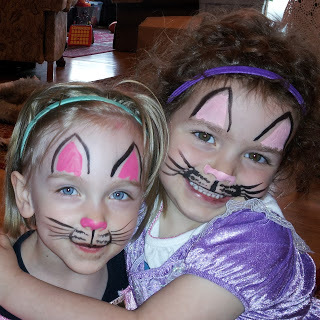 Best Friends.Little Brother, Blair, arrived home from school tousled, scratched and with a badly torn shirt.Mom blinked.Let’s face it, this wasn’t his normal look.Moving quickly to her disheveled son, she asked the question I think would hover on all our lips. “What happened to you?!”Blair frowned. “Bruce beat up on me!”Mom was aghast. (Oooh! Good word!) “How come? Can’t you handle little Bruce?”I should probably point out that Bruce was a small chap. Half the size of my brother.“I can’t hit him!” Blair exclaimed. “He’s my friend!”Many of us are taught to turn the other cheek. Some of us actually do . . .* * *In Vietnam a little girl was critically injured by flying shrapnel.She needed a blood transfusion.A group of young children were canvassed for a volunteer to give some blood.One little boy slowly raised his hand.As the doctor prepared him for the transfusion, the little boy let out a shuddering sob.When the needle was inserted and the blood began to flow, the sobs became a steady, soft crying.A nurse spoke to the boy and asked him if he was alright.The boy looked at her. “When am I going to die?” he asked.She smiled. “You aren’t going to die.”“But—what about when all my blood is gone?”“Oh, Son, we aren’t going to take all your blood. Just a little bit.”“Oh.” “You thought you were going to give everything you had and then die?”He nodded.“But why, then, would you offer to give this little girl your blood?”His answer was simple. “Because she is my friend!”
Best Friends.Little Brother, Blair, arrived home from school tousled, scratched and with a badly torn shirt.Mom blinked.Let’s face it, this wasn’t his normal look.Moving quickly to her disheveled son, she asked the question I think would hover on all our lips. “What happened to you?!”Blair frowned. “Bruce beat up on me!”Mom was aghast. (Oooh! Good word!) “How come? Can’t you handle little Bruce?”I should probably point out that Bruce was a small chap. Half the size of my brother.“I can’t hit him!” Blair exclaimed. “He’s my friend!”Many of us are taught to turn the other cheek. Some of us actually do . . .* * *In Vietnam a little girl was critically injured by flying shrapnel.She needed a blood transfusion.A group of young children were canvassed for a volunteer to give some blood.One little boy slowly raised his hand.As the doctor prepared him for the transfusion, the little boy let out a shuddering sob.When the needle was inserted and the blood began to flow, the sobs became a steady, soft crying.A nurse spoke to the boy and asked him if he was alright.The boy looked at her. “When am I going to die?” he asked.She smiled. “You aren’t going to die.”“But—what about when all my blood is gone?”“Oh, Son, we aren’t going to take all your blood. Just a little bit.”“Oh.” “You thought you were going to give everything you had and then die?”He nodded.“But why, then, would you offer to give this little girl your blood?”His answer was simple. “Because she is my friend!”
 Best Friends.Little Brother, Blair, arrived home from school tousled, scratched and with a badly torn shirt.Mom blinked.Let’s face it, this wasn’t his normal look.Moving quickly to her disheveled son, she asked the question I think would hover on all our lips. “What happened to you?!”Blair frowned. “Bruce beat up on me!”Mom was aghast. (Oooh! Good word!) “How come? Can’t you handle little Bruce?”I should probably point out that Bruce was a small chap. Half the size of my brother.“I can’t hit him!” Blair exclaimed. “He’s my friend!”Many of us are taught to turn the other cheek. Some of us actually do . . .* * *In Vietnam a little girl was critically injured by flying shrapnel.She needed a blood transfusion.A group of young children were canvassed for a volunteer to give some blood.One little boy slowly raised his hand.As the doctor prepared him for the transfusion, the little boy let out a shuddering sob.When the needle was inserted and the blood began to flow, the sobs became a steady, soft crying.A nurse spoke to the boy and asked him if he was alright.The boy looked at her. “When am I going to die?” he asked.She smiled. “You aren’t going to die.”“But—what about when all my blood is gone?”“Oh, Son, we aren’t going to take all your blood. Just a little bit.”“Oh.” “You thought you were going to give everything you had and then die?”He nodded.“But why, then, would you offer to give this little girl your blood?”His answer was simple. “Because she is my friend!”
Best Friends.Little Brother, Blair, arrived home from school tousled, scratched and with a badly torn shirt.Mom blinked.Let’s face it, this wasn’t his normal look.Moving quickly to her disheveled son, she asked the question I think would hover on all our lips. “What happened to you?!”Blair frowned. “Bruce beat up on me!”Mom was aghast. (Oooh! Good word!) “How come? Can’t you handle little Bruce?”I should probably point out that Bruce was a small chap. Half the size of my brother.“I can’t hit him!” Blair exclaimed. “He’s my friend!”Many of us are taught to turn the other cheek. Some of us actually do . . .* * *In Vietnam a little girl was critically injured by flying shrapnel.She needed a blood transfusion.A group of young children were canvassed for a volunteer to give some blood.One little boy slowly raised his hand.As the doctor prepared him for the transfusion, the little boy let out a shuddering sob.When the needle was inserted and the blood began to flow, the sobs became a steady, soft crying.A nurse spoke to the boy and asked him if he was alright.The boy looked at her. “When am I going to die?” he asked.She smiled. “You aren’t going to die.”“But—what about when all my blood is gone?”“Oh, Son, we aren’t going to take all your blood. Just a little bit.”“Oh.” “You thought you were going to give everything you had and then die?”He nodded.“But why, then, would you offer to give this little girl your blood?”His answer was simple. “Because she is my friend!”
Published on October 27, 2017 08:34
October 26, 2017
Mud
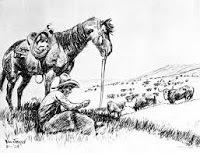 Will JamesThe romantic picture of the lean, seasoned, tough, sun-browned cowboy riding his pony across the endless, wind-swept prairies, hand-rolled cigarette clamped between firm lips and keen eyes narrowed against the glint of the sun, is just that. A picture.According to my Uncle Owen, the reality was far, far different.Also . . .The great cattle-liners of today didn’t exist in the 1920s. No convenient 18-wheeler showed up at the home corral to load and transport your cattle to wherever you needed them to go.Instead, cattle were herded from their native pastures (sometimes a trip of many, many days) to the nearest railhead and put into cars there.When arrangements went according to plan.And there were cars available . . .Over to Uncle Owen:The fall of 1924 was extremely wet.Crops were not harvested until late in the year and the sugar beets were very difficult to get out of the ground.We cut our beef (selected the animals that were ready for slaughter) along in October, intending to drive them to Magrath (Alberta) to ship out to Winnipeg. But when we got them all ready to leave, we found that we couldn’t get stock cars to ship them in.So we had to herd them for a week or ten days. (With no corrals, someone had to be in the saddle 24 hours a day to keep the cattle together.)It was during this period that I got my first experience at night herding in bad weather. We had about 300 head of beef cut out and I took a shift herding these cattle during each night for about five or six hours.Pure misery.It was snowing and raining most of the time but not cold enough for the snow to accumulate on the ground. It melted just about as fast as it fell and the ground was a swamp any place you wanted to put your foot.When we finally did get cars and were able to take the cattle into Magrath, we had to ride our horses all the time we were handling them in the stockyards because the water and mud was so deep [there] that a man couldn’t wade around in it.
Will JamesThe romantic picture of the lean, seasoned, tough, sun-browned cowboy riding his pony across the endless, wind-swept prairies, hand-rolled cigarette clamped between firm lips and keen eyes narrowed against the glint of the sun, is just that. A picture.According to my Uncle Owen, the reality was far, far different.Also . . .The great cattle-liners of today didn’t exist in the 1920s. No convenient 18-wheeler showed up at the home corral to load and transport your cattle to wherever you needed them to go.Instead, cattle were herded from their native pastures (sometimes a trip of many, many days) to the nearest railhead and put into cars there.When arrangements went according to plan.And there were cars available . . .Over to Uncle Owen:The fall of 1924 was extremely wet.Crops were not harvested until late in the year and the sugar beets were very difficult to get out of the ground.We cut our beef (selected the animals that were ready for slaughter) along in October, intending to drive them to Magrath (Alberta) to ship out to Winnipeg. But when we got them all ready to leave, we found that we couldn’t get stock cars to ship them in.So we had to herd them for a week or ten days. (With no corrals, someone had to be in the saddle 24 hours a day to keep the cattle together.)It was during this period that I got my first experience at night herding in bad weather. We had about 300 head of beef cut out and I took a shift herding these cattle during each night for about five or six hours.Pure misery.It was snowing and raining most of the time but not cold enough for the snow to accumulate on the ground. It melted just about as fast as it fell and the ground was a swamp any place you wanted to put your foot.When we finally did get cars and were able to take the cattle into Magrath, we had to ride our horses all the time we were handling them in the stockyards because the water and mud was so deep [there] that a man couldn’t wade around in it.
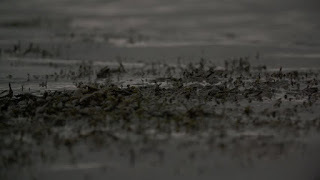 I don’t know about you, but the picture of someone hunched and freezing against the onslaught of rain and snow and with his horse knee-deep in mud and water rather spoils my image of the ‘cowboy’.Maybe it’s for the best . . .
I don’t know about you, but the picture of someone hunched and freezing against the onslaught of rain and snow and with his horse knee-deep in mud and water rather spoils my image of the ‘cowboy’.Maybe it’s for the best . . .
Published on October 26, 2017 08:52
October 25, 2017
The Morning Bath
Just a little glimpse into the round-up days of 1918.In the words of my Dad's eldest brother, Uncle Owen Stringam . . .
 Photo CreditRope corral.Along in July or August of 1918, my father [George L. Stringam] sent Bert Quinton and I along to the roundup to bring back the strays.We were awakened at 4:00 AM by the breakfast bell.The night herder had already brought in the saddle horse herd and put them in a rope corral. (A rope was tied to short posts about four feet off the ground and was just large enough to hold a crowded horse herd.)Each cowboy came out to rope his horse. No one was allowed to swing a loop over his head for fear of frightening the horses. All horse roping was done from the outside by a back-hand throw and the horse was then worked around to the drop rope gate and out of the corral.I watched one young fellow saddle up his horse and [before mounting] walk him around for a while to get the kink (hump) out of the horse’s back.[A little aside here: Many of these horses were newly-broke and still didn’t like the idea of having something strapped to their backs. For the first while, they would protest in any way they could. Usually by arching their back up, perhaps to try to get the saddle as far away from themselves as they could!]Gradually, the hump subsided and the horse seemed okay.Now, about ten feet below the corral, in a small depression, was a large spring where the cook came for water. This spring was fenced to keep out the livestock.Once the young fellow was aboard (mounted) the horse started to buck, heading straight for the spring.He came to a sudden stop as he hit the fence.The cowboy didn’t.Nothing like a cold, refreshing bath before the start of the workday.
Photo CreditRope corral.Along in July or August of 1918, my father [George L. Stringam] sent Bert Quinton and I along to the roundup to bring back the strays.We were awakened at 4:00 AM by the breakfast bell.The night herder had already brought in the saddle horse herd and put them in a rope corral. (A rope was tied to short posts about four feet off the ground and was just large enough to hold a crowded horse herd.)Each cowboy came out to rope his horse. No one was allowed to swing a loop over his head for fear of frightening the horses. All horse roping was done from the outside by a back-hand throw and the horse was then worked around to the drop rope gate and out of the corral.I watched one young fellow saddle up his horse and [before mounting] walk him around for a while to get the kink (hump) out of the horse’s back.[A little aside here: Many of these horses were newly-broke and still didn’t like the idea of having something strapped to their backs. For the first while, they would protest in any way they could. Usually by arching their back up, perhaps to try to get the saddle as far away from themselves as they could!]Gradually, the hump subsided and the horse seemed okay.Now, about ten feet below the corral, in a small depression, was a large spring where the cook came for water. This spring was fenced to keep out the livestock.Once the young fellow was aboard (mounted) the horse started to buck, heading straight for the spring.He came to a sudden stop as he hit the fence.The cowboy didn’t.Nothing like a cold, refreshing bath before the start of the workday.
 Photo CreditRope corral.Along in July or August of 1918, my father [George L. Stringam] sent Bert Quinton and I along to the roundup to bring back the strays.We were awakened at 4:00 AM by the breakfast bell.The night herder had already brought in the saddle horse herd and put them in a rope corral. (A rope was tied to short posts about four feet off the ground and was just large enough to hold a crowded horse herd.)Each cowboy came out to rope his horse. No one was allowed to swing a loop over his head for fear of frightening the horses. All horse roping was done from the outside by a back-hand throw and the horse was then worked around to the drop rope gate and out of the corral.I watched one young fellow saddle up his horse and [before mounting] walk him around for a while to get the kink (hump) out of the horse’s back.[A little aside here: Many of these horses were newly-broke and still didn’t like the idea of having something strapped to their backs. For the first while, they would protest in any way they could. Usually by arching their back up, perhaps to try to get the saddle as far away from themselves as they could!]Gradually, the hump subsided and the horse seemed okay.Now, about ten feet below the corral, in a small depression, was a large spring where the cook came for water. This spring was fenced to keep out the livestock.Once the young fellow was aboard (mounted) the horse started to buck, heading straight for the spring.He came to a sudden stop as he hit the fence.The cowboy didn’t.Nothing like a cold, refreshing bath before the start of the workday.
Photo CreditRope corral.Along in July or August of 1918, my father [George L. Stringam] sent Bert Quinton and I along to the roundup to bring back the strays.We were awakened at 4:00 AM by the breakfast bell.The night herder had already brought in the saddle horse herd and put them in a rope corral. (A rope was tied to short posts about four feet off the ground and was just large enough to hold a crowded horse herd.)Each cowboy came out to rope his horse. No one was allowed to swing a loop over his head for fear of frightening the horses. All horse roping was done from the outside by a back-hand throw and the horse was then worked around to the drop rope gate and out of the corral.I watched one young fellow saddle up his horse and [before mounting] walk him around for a while to get the kink (hump) out of the horse’s back.[A little aside here: Many of these horses were newly-broke and still didn’t like the idea of having something strapped to their backs. For the first while, they would protest in any way they could. Usually by arching their back up, perhaps to try to get the saddle as far away from themselves as they could!]Gradually, the hump subsided and the horse seemed okay.Now, about ten feet below the corral, in a small depression, was a large spring where the cook came for water. This spring was fenced to keep out the livestock.Once the young fellow was aboard (mounted) the horse started to buck, heading straight for the spring.He came to a sudden stop as he hit the fence.The cowboy didn’t.Nothing like a cold, refreshing bath before the start of the workday.
Published on October 25, 2017 09:42
October 24, 2017
Slipping in Memories
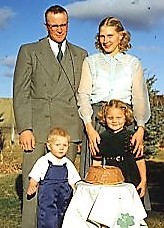 Mom and Dad, Chris and Jerry.
Mom and Dad, Chris and Jerry.If you look closely . . .What articles of clothing do you treasure?Get foolishly sentimental (ie. I’m never washing this!) over.And why?That jacket you bought that Peter Tork sneezed on when you went to that amazing concert back in ’66?The red dress that was so eye-popping and perfect at the Christmas dance in ’80?Those jeans that flattered so well and, even as they became more and more ragged, continued to be your best and truest friends from ’78 through to ‘92?Those boots that were sooo warm and sooo comfortable that you wept when the sole ripped right out of the left one?That slip.Slip?Ummm . . . Maybe I should explain . . .My Mom was diagnosed with Parkinson’s Disease in the 1985 at the age of 61.It is a horrifying, wasting sort of illness.For several years, she gamely battled it, exercising, proper diet.Medications.But the disease won and she passed into eternity on April 9, 2002.We were happy for her – she had been so ill.But sad for the rest of us.In the months after her death, Dad found homes for her jewellery, clothes and keepsakes.Each of her three daughters carted home boxes of Mom’s ‘stuff’.Special because it had been hers.I had great fun going through my boxes.Immersing myself in the memories.I put jewellery into my own case, remembering special pieces Mom had worn.Set fancy, fun hats on the shelf in the closet, thinking about the times I had sneaked into her closet to play dress-up with them.Hung up dresses and other clothes. More memories.And went back to my normal life.Then, Sunday rolled around.I should point out here that we dress in our best for Sunday worship services.It’s just our way . . .I scrambled through my closet for a slip and grabbed the first one I came to. One of my Mom's.I slipped it on.And was immediately immersed in the soft scent of Mom’s ‘special occasion’ perfume.I had forgotten.Mom had been ill for so long, and, in all that time, had worn no perfume at all.Suddenly, I was lost in memories.Mom hugging me before she and Dad went out somewhere special.Mom sitting beside me in Church.Mom smiling across from me in a restaurant.And thousands and thousands more.It took me a long time to get ready that day.Stepping from the softly-lit past into the garishly -coloured present took great effort.After church, I hung the slip up carefully.Almost reverently.
And vowed never to wash it again.
Published on October 24, 2017 07:40
October 23, 2017
(Un)Befuddled
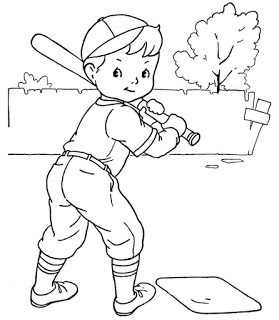
The world likes baseball, I am sure,And loves their teams, famed or obscure,But what of those who don’t partake?Well this should help thwart a mistake:
Baseball bat: This is a wood or metal barThat, like the ball, can fly afar.
Foul ball: For just a moment you don’t quit, Because you think, I got a hit!
Babe Ruth: A player who was really great,One (who they say) was overweight.
Right field: A quiet place where only youCan sit and watch where flowers ‘grew’.
Right Field (also): Until you hear a clang, Oh No!And someone shouts, “Look out below!”
Fly ball: That moment when the sun (it’s said)Drops a boulder on your head.
Shortstop: Has mostly ground balls, so you’ll thrive,And thus, this ballgame, you’ll survive.
Line drive: That point where something whizzes through,And you bid your shortstop days adieu.
Innings: How long it is before snack time, Divided tidily by nine.
Pro Athletes:Play games and practice vanity,Speak their language. And profanity.
The world of baseball can befuddle,And leave you in a murky puddle.Now, aren’t you glad you stopped today,So we could take your fears away?
 Mondays do get knocked a lot,
Mondays do get knocked a lot,With poetry, we three besought,To try to make the week begin, With gentle thoughts-- perhaps a grin? So Jenny and Delores, we,Now post our poems for you to see.
And when you’ve read what we have brought, Did we help? Or did we not . . .
And next week in our neighbourhood,We tackle 'feet'. It will be good!
Published on October 23, 2017 07:25
October 22, 2017
Four Cold Noses
As the only veterinarian in a 100-mile radius, Dad certainly got around. Within months of his graduation, he was being called further and further afield.Pun intended.But thus far in his career, he had never performed a caesarean.Oh, he had watched. Even assisted a time or two.But never completed one solo.For a new veterinarian, there must be a first . . .From Dad’s journals:
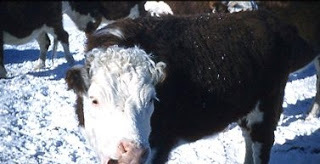 As winter came on, we found the roads often heavy with snow. A trip could give good roads one day and be plugged the next. When I went on a call, I wanted to be sure I would be able to get home before the roads drifted in.On one particular call, it was to a farm to the west of home and the road was often bad in snowy weather.The case was a cow in labour. Upon examination, it became quite evident that she hadn’t dilated very much. I told the farmer that I could give the cow a shot of hormone and she should be ready to calve by morning.The only alternative would be a caesarian to deliver the calf now. I didn’t want to do the surgery because the wind was blowing hard and the road would be blocked in an hour or so. Another drawback was the fact that there wasn’t a warm place to do the job. His barn was so in need of repair that it would barely act as a windbreak.Another thing worrying me was my lack of experience. This would be my first caesarian.With the farmer’s insistence, I decided to go to it right away.We took the cow to the barn and to the corner farthest from the wind and I parked my car close by and kept it running so as to have a place to warm up from time to time.I put the cow to sleep and started to work. As soon as the calf was out, it was taken to the house quickly to keep it from freezing.Now it was time to start sewing.I could only work a few minutes at a time because of the cold and had to get in the car frequently to warm up.Finally, the job was completed and now we had to do something to keep the cow warm. There was lots of straw so we buried the cow completely.Next, they brought in their small herd of sheep and they helped to keep the wind away.As soon as this was done I was on my way home, and not a bit too soon. The road was so badly drifted that I was glad to get through.The wind continued all next day and there was no traffic in that direction for two weeks.Under the circumstances, I really didn’t think the cow had a chance to survive. The temperature dipped to 25 below zero (F) that night and stayed much the same for the next two weeks.I didn’t have a telephone and was reluctant to see the farmer, but when I did, he surprised me by telling me the cow came through very well. She was on her feet the next morning and looking for the calf.“I knew she would be okay,” he said.I guess he had more confidence in me that I did.
As winter came on, we found the roads often heavy with snow. A trip could give good roads one day and be plugged the next. When I went on a call, I wanted to be sure I would be able to get home before the roads drifted in.On one particular call, it was to a farm to the west of home and the road was often bad in snowy weather.The case was a cow in labour. Upon examination, it became quite evident that she hadn’t dilated very much. I told the farmer that I could give the cow a shot of hormone and she should be ready to calve by morning.The only alternative would be a caesarian to deliver the calf now. I didn’t want to do the surgery because the wind was blowing hard and the road would be blocked in an hour or so. Another drawback was the fact that there wasn’t a warm place to do the job. His barn was so in need of repair that it would barely act as a windbreak.Another thing worrying me was my lack of experience. This would be my first caesarian.With the farmer’s insistence, I decided to go to it right away.We took the cow to the barn and to the corner farthest from the wind and I parked my car close by and kept it running so as to have a place to warm up from time to time.I put the cow to sleep and started to work. As soon as the calf was out, it was taken to the house quickly to keep it from freezing.Now it was time to start sewing.I could only work a few minutes at a time because of the cold and had to get in the car frequently to warm up.Finally, the job was completed and now we had to do something to keep the cow warm. There was lots of straw so we buried the cow completely.Next, they brought in their small herd of sheep and they helped to keep the wind away.As soon as this was done I was on my way home, and not a bit too soon. The road was so badly drifted that I was glad to get through.The wind continued all next day and there was no traffic in that direction for two weeks.Under the circumstances, I really didn’t think the cow had a chance to survive. The temperature dipped to 25 below zero (F) that night and stayed much the same for the next two weeks.I didn’t have a telephone and was reluctant to see the farmer, but when I did, he surprised me by telling me the cow came through very well. She was on her feet the next morning and looking for the calf.“I knew she would be okay,” he said.I guess he had more confidence in me that I did.
I never did tell him that this was the first caesarian I had done since leaving College.
 As winter came on, we found the roads often heavy with snow. A trip could give good roads one day and be plugged the next. When I went on a call, I wanted to be sure I would be able to get home before the roads drifted in.On one particular call, it was to a farm to the west of home and the road was often bad in snowy weather.The case was a cow in labour. Upon examination, it became quite evident that she hadn’t dilated very much. I told the farmer that I could give the cow a shot of hormone and she should be ready to calve by morning.The only alternative would be a caesarian to deliver the calf now. I didn’t want to do the surgery because the wind was blowing hard and the road would be blocked in an hour or so. Another drawback was the fact that there wasn’t a warm place to do the job. His barn was so in need of repair that it would barely act as a windbreak.Another thing worrying me was my lack of experience. This would be my first caesarian.With the farmer’s insistence, I decided to go to it right away.We took the cow to the barn and to the corner farthest from the wind and I parked my car close by and kept it running so as to have a place to warm up from time to time.I put the cow to sleep and started to work. As soon as the calf was out, it was taken to the house quickly to keep it from freezing.Now it was time to start sewing.I could only work a few minutes at a time because of the cold and had to get in the car frequently to warm up.Finally, the job was completed and now we had to do something to keep the cow warm. There was lots of straw so we buried the cow completely.Next, they brought in their small herd of sheep and they helped to keep the wind away.As soon as this was done I was on my way home, and not a bit too soon. The road was so badly drifted that I was glad to get through.The wind continued all next day and there was no traffic in that direction for two weeks.Under the circumstances, I really didn’t think the cow had a chance to survive. The temperature dipped to 25 below zero (F) that night and stayed much the same for the next two weeks.I didn’t have a telephone and was reluctant to see the farmer, but when I did, he surprised me by telling me the cow came through very well. She was on her feet the next morning and looking for the calf.“I knew she would be okay,” he said.I guess he had more confidence in me that I did.
As winter came on, we found the roads often heavy with snow. A trip could give good roads one day and be plugged the next. When I went on a call, I wanted to be sure I would be able to get home before the roads drifted in.On one particular call, it was to a farm to the west of home and the road was often bad in snowy weather.The case was a cow in labour. Upon examination, it became quite evident that she hadn’t dilated very much. I told the farmer that I could give the cow a shot of hormone and she should be ready to calve by morning.The only alternative would be a caesarian to deliver the calf now. I didn’t want to do the surgery because the wind was blowing hard and the road would be blocked in an hour or so. Another drawback was the fact that there wasn’t a warm place to do the job. His barn was so in need of repair that it would barely act as a windbreak.Another thing worrying me was my lack of experience. This would be my first caesarian.With the farmer’s insistence, I decided to go to it right away.We took the cow to the barn and to the corner farthest from the wind and I parked my car close by and kept it running so as to have a place to warm up from time to time.I put the cow to sleep and started to work. As soon as the calf was out, it was taken to the house quickly to keep it from freezing.Now it was time to start sewing.I could only work a few minutes at a time because of the cold and had to get in the car frequently to warm up.Finally, the job was completed and now we had to do something to keep the cow warm. There was lots of straw so we buried the cow completely.Next, they brought in their small herd of sheep and they helped to keep the wind away.As soon as this was done I was on my way home, and not a bit too soon. The road was so badly drifted that I was glad to get through.The wind continued all next day and there was no traffic in that direction for two weeks.Under the circumstances, I really didn’t think the cow had a chance to survive. The temperature dipped to 25 below zero (F) that night and stayed much the same for the next two weeks.I didn’t have a telephone and was reluctant to see the farmer, but when I did, he surprised me by telling me the cow came through very well. She was on her feet the next morning and looking for the calf.“I knew she would be okay,” he said.I guess he had more confidence in me that I did.I never did tell him that this was the first caesarian I had done since leaving College.
Published on October 22, 2017 07:26
October 21, 2017
GETTING It Right
I love Daddy's stories!
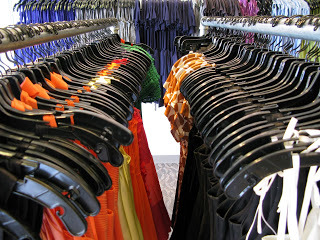 “I’m shopping for my wife,” said he.“For things she needs immediately.And while I’m here, I thought I’d getA special something for my Pet.”
“I’m shopping for my wife,” said he.“For things she needs immediately.And while I’m here, I thought I’d getA special something for my Pet.”
He wandered round the store a while,And saw things staid. Or infantile.Then found that he had ambled toThe women’s clothes all starched and new.
His eyes lit up as he assessedNew ways to help his wife get dressed.In gowns of rough or slinky mein,In shades from black to tangerine.
He wandered further through the storeSeeking something she’d adore,High or low or bourgeoisie,He fin-al-ly came o’er to me.
“It seemed so simple,” he declared.“But now I’ve looked, and now I’m scared.The clothes selection’s vast and mixed,And I can’t seem to choose betwixt.”
“There’s something that she needed, though,To wear around the bungalow.So help me please, I do implore.There must be something in your store!”
“There’s much to choose from, sir,” I said.“That’s sure to please your thoroughbred.But there's one thing I need to know,Just how big is her bungalow?”
 “I’m shopping for my wife,” said he.“For things she needs immediately.And while I’m here, I thought I’d getA special something for my Pet.”
“I’m shopping for my wife,” said he.“For things she needs immediately.And while I’m here, I thought I’d getA special something for my Pet.”He wandered round the store a while,And saw things staid. Or infantile.Then found that he had ambled toThe women’s clothes all starched and new.
His eyes lit up as he assessedNew ways to help his wife get dressed.In gowns of rough or slinky mein,In shades from black to tangerine.
He wandered further through the storeSeeking something she’d adore,High or low or bourgeoisie,He fin-al-ly came o’er to me.
“It seemed so simple,” he declared.“But now I’ve looked, and now I’m scared.The clothes selection’s vast and mixed,And I can’t seem to choose betwixt.”
“There’s something that she needed, though,To wear around the bungalow.So help me please, I do implore.There must be something in your store!”
“There’s much to choose from, sir,” I said.“That’s sure to please your thoroughbred.But there's one thing I need to know,Just how big is her bungalow?”
Published on October 21, 2017 08:27
October 20, 2017
First Winter
Digging through Grandma Berg's Journals again . . .
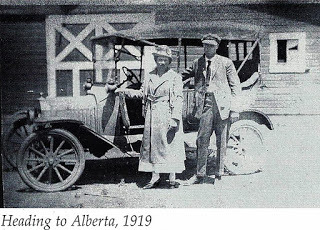 Grandma and Grampa Berg were married in a small Lutheran church in Blackfoot, Idaho on April 20, 1919.Throughout the summer, they worked on the farm they shared with another couple, Nanny and Axel Karlsson. In October of that year, they moved to their new land west of Millicent, Alberta, where they would raise their family.But their first winter wasn’t spent on that land. Instead, they went with another couple, the Palms, to the Fort McMurray area to run a trapline.Our story starts there . . .
Grandma and Grampa Berg were married in a small Lutheran church in Blackfoot, Idaho on April 20, 1919.Throughout the summer, they worked on the farm they shared with another couple, Nanny and Axel Karlsson. In October of that year, they moved to their new land west of Millicent, Alberta, where they would raise their family.But their first winter wasn’t spent on that land. Instead, they went with another couple, the Palms, to the Fort McMurray area to run a trapline.Our story starts there . . .
What a winter it was! We had brought a supply of kerosene and food—flour, sugar, jam, beans, dried fruit, salted pork, powdered milk, butter and frozen potatoes—which supplemented with moose and rabbit meat made our diet quite adequate.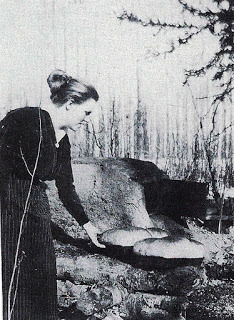 I baked bread in a stone oven built by Petrus outside the cabin. A fire was built inside the oven until the stones were hot. The heat from the rocks baked lovely bread!The two men were often in the wilderness for days at a time, tending their trapline with snowshoes and dog teams. Although Petrus was bush wise, one time they lost their bearings in a storm and were wandering for nine days before stumbling on another trapper’s cabin. The trapper wisely, slowly brought the half-starved pair back onto food by allowing them only one pancake every hour over a period of hours.Never had pancakes tasted so good!I was expecting my first baby in January and plans were made to leave before that time. However, the snow kept falling and by Christmas time the train stopped running. [Mrs. Palm and I] prepared for the baby by knitting and sewing little garments out of yarn and flannelette we had brought with us . . .When I went into labour, Petrus ran behind the dogteam twenty miles to Lac La Biche where he had been told of a midwife. When he found the experienced native midwife, she first hesitated until an RCMP constable persuaded her to come. Many precious hours had passed and Petrus was beside himself. The woman finally gathered the necessary supplies and settled herself into the sled.With anxious urging, the hardy dogs made a short time of the twenty or more miles, arriving at the cabin about midnight.Soon Petrus was greeted by the cry of his first-born son. All the frustrations of the day were forgotten in the joy of holding this precious child.There is some disagreement among family members about whether Grandpa and the midwife arrived in time to assist in the birth. To settle the issue, my Uncle Roy put the question to Uncle Glen, the baby in the story.“Glen, you were there. Were you delivered by the midwife or not?”Uncle Glen turned his head at a wry angle and taking his chin in his left hand, with deep thought and deliberations, he answered, “You know, I can’t remember.”
I baked bread in a stone oven built by Petrus outside the cabin. A fire was built inside the oven until the stones were hot. The heat from the rocks baked lovely bread!The two men were often in the wilderness for days at a time, tending their trapline with snowshoes and dog teams. Although Petrus was bush wise, one time they lost their bearings in a storm and were wandering for nine days before stumbling on another trapper’s cabin. The trapper wisely, slowly brought the half-starved pair back onto food by allowing them only one pancake every hour over a period of hours.Never had pancakes tasted so good!I was expecting my first baby in January and plans were made to leave before that time. However, the snow kept falling and by Christmas time the train stopped running. [Mrs. Palm and I] prepared for the baby by knitting and sewing little garments out of yarn and flannelette we had brought with us . . .When I went into labour, Petrus ran behind the dogteam twenty miles to Lac La Biche where he had been told of a midwife. When he found the experienced native midwife, she first hesitated until an RCMP constable persuaded her to come. Many precious hours had passed and Petrus was beside himself. The woman finally gathered the necessary supplies and settled herself into the sled.With anxious urging, the hardy dogs made a short time of the twenty or more miles, arriving at the cabin about midnight.Soon Petrus was greeted by the cry of his first-born son. All the frustrations of the day were forgotten in the joy of holding this precious child.There is some disagreement among family members about whether Grandpa and the midwife arrived in time to assist in the birth. To settle the issue, my Uncle Roy put the question to Uncle Glen, the baby in the story.“Glen, you were there. Were you delivered by the midwife or not?”Uncle Glen turned his head at a wry angle and taking his chin in his left hand, with deep thought and deliberations, he answered, “You know, I can’t remember.”
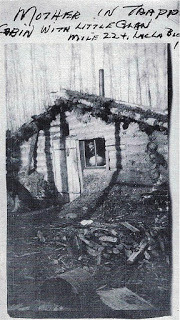
 Grandma and Grampa Berg were married in a small Lutheran church in Blackfoot, Idaho on April 20, 1919.Throughout the summer, they worked on the farm they shared with another couple, Nanny and Axel Karlsson. In October of that year, they moved to their new land west of Millicent, Alberta, where they would raise their family.But their first winter wasn’t spent on that land. Instead, they went with another couple, the Palms, to the Fort McMurray area to run a trapline.Our story starts there . . .
Grandma and Grampa Berg were married in a small Lutheran church in Blackfoot, Idaho on April 20, 1919.Throughout the summer, they worked on the farm they shared with another couple, Nanny and Axel Karlsson. In October of that year, they moved to their new land west of Millicent, Alberta, where they would raise their family.But their first winter wasn’t spent on that land. Instead, they went with another couple, the Palms, to the Fort McMurray area to run a trapline.Our story starts there . . .
What a winter it was! We had brought a supply of kerosene and food—flour, sugar, jam, beans, dried fruit, salted pork, powdered milk, butter and frozen potatoes—which supplemented with moose and rabbit meat made our diet quite adequate.
 I baked bread in a stone oven built by Petrus outside the cabin. A fire was built inside the oven until the stones were hot. The heat from the rocks baked lovely bread!The two men were often in the wilderness for days at a time, tending their trapline with snowshoes and dog teams. Although Petrus was bush wise, one time they lost their bearings in a storm and were wandering for nine days before stumbling on another trapper’s cabin. The trapper wisely, slowly brought the half-starved pair back onto food by allowing them only one pancake every hour over a period of hours.Never had pancakes tasted so good!I was expecting my first baby in January and plans were made to leave before that time. However, the snow kept falling and by Christmas time the train stopped running. [Mrs. Palm and I] prepared for the baby by knitting and sewing little garments out of yarn and flannelette we had brought with us . . .When I went into labour, Petrus ran behind the dogteam twenty miles to Lac La Biche where he had been told of a midwife. When he found the experienced native midwife, she first hesitated until an RCMP constable persuaded her to come. Many precious hours had passed and Petrus was beside himself. The woman finally gathered the necessary supplies and settled herself into the sled.With anxious urging, the hardy dogs made a short time of the twenty or more miles, arriving at the cabin about midnight.Soon Petrus was greeted by the cry of his first-born son. All the frustrations of the day were forgotten in the joy of holding this precious child.There is some disagreement among family members about whether Grandpa and the midwife arrived in time to assist in the birth. To settle the issue, my Uncle Roy put the question to Uncle Glen, the baby in the story.“Glen, you were there. Were you delivered by the midwife or not?”Uncle Glen turned his head at a wry angle and taking his chin in his left hand, with deep thought and deliberations, he answered, “You know, I can’t remember.”
I baked bread in a stone oven built by Petrus outside the cabin. A fire was built inside the oven until the stones were hot. The heat from the rocks baked lovely bread!The two men were often in the wilderness for days at a time, tending their trapline with snowshoes and dog teams. Although Petrus was bush wise, one time they lost their bearings in a storm and were wandering for nine days before stumbling on another trapper’s cabin. The trapper wisely, slowly brought the half-starved pair back onto food by allowing them only one pancake every hour over a period of hours.Never had pancakes tasted so good!I was expecting my first baby in January and plans were made to leave before that time. However, the snow kept falling and by Christmas time the train stopped running. [Mrs. Palm and I] prepared for the baby by knitting and sewing little garments out of yarn and flannelette we had brought with us . . .When I went into labour, Petrus ran behind the dogteam twenty miles to Lac La Biche where he had been told of a midwife. When he found the experienced native midwife, she first hesitated until an RCMP constable persuaded her to come. Many precious hours had passed and Petrus was beside himself. The woman finally gathered the necessary supplies and settled herself into the sled.With anxious urging, the hardy dogs made a short time of the twenty or more miles, arriving at the cabin about midnight.Soon Petrus was greeted by the cry of his first-born son. All the frustrations of the day were forgotten in the joy of holding this precious child.There is some disagreement among family members about whether Grandpa and the midwife arrived in time to assist in the birth. To settle the issue, my Uncle Roy put the question to Uncle Glen, the baby in the story.“Glen, you were there. Were you delivered by the midwife or not?”Uncle Glen turned his head at a wry angle and taking his chin in his left hand, with deep thought and deliberations, he answered, “You know, I can’t remember.”

Published on October 20, 2017 07:02
October 19, 2017
Harvest in a Hurry
It's harvest season.Time for a story about another harvest.In another era . . .
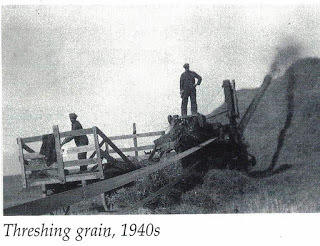 How it was done under normal circumstances.
How it was done under normal circumstances.
You can see the Bundle Rack in the background...First, a bit of background . . .Well into the 1940s, the Berg family ran a threshing machine fed by bundles (sheaves) of grain transported by bundle ‘racks’ pulled by a team of horses. Bundle racks were trailers usually 14 to 16 feet long and 8 feet wide, with a 5-foot wood barrier front and back. The rack was mounted on a four-wheeled running gear with the two front wheels attached to the tongue—a long wooden pole where the horses were attached and which acted as a steering apparatus for the front wheels.The driverless team pulling the rack was controlled by the man doing the loading of the sheaves and directed by the commands, “Get up” or “Whoa”. The reins were tied to a ‘V’ notched in the top board of the front of the rack and the horses were steered next to the stooks (sheaves of grain gathered and standing together) by the man as he walked alongside. With his pitchfork, he could reach out and put pressure on either rein, depending on where he wanted the team to go.Normally, it was a calm, peaceful and surprisingly quiet operation. At least until they reached the threshing machine.Now on to my story . . .The brothers were threshing a field of wheat on the South Farm, just across the irrigation canal from the home place. All had gone well to this moment. Carlo, their hired man, had his rack partly filled and Don, with a full load was heading toward the thresher. Bern, the second eldest son, and his team, Maud and Dick were stopped across the field while Bern answered a call of nature.Suddenly, a pheasant burst out of the undergrowth, startling Bern’s team.You have to know that horses have one response to everything out of the ordinary. Run!They took off like a shot.Bern got his pants into running position and sprinted after them. But before he could affect any form of control, they spooked Carlo’s team, who joined in the race.Carlo managed to grab the front of his rack and began climbing up toward the reins.That was the last view either of the brothers had of him.The team had been heading for the canal, but made a sharp turn, dumping Carlo, the rack and the load into the canal.Carlo was on the side of the rack that turned over and, fearing for his safety, Don left his team and ran to see if he was all right. But Carlo’s head appeared suddenly above the bank. He was still waving his hands and yelling, “Whoa! Whoa!”Meanwhile, Carlo’s team, minus the rack but still pulling the empty running gear, circled back toward Don’s team. Who now joined the stampede.Don ran back to where he had left them to find a large pile of sheaves, but no horses.Or rack.When they finally caught their respective teams, they surveyed the damage.Then silently agreed it was time for lunch.
 How it was done under normal circumstances.
How it was done under normal circumstances.You can see the Bundle Rack in the background...First, a bit of background . . .Well into the 1940s, the Berg family ran a threshing machine fed by bundles (sheaves) of grain transported by bundle ‘racks’ pulled by a team of horses. Bundle racks were trailers usually 14 to 16 feet long and 8 feet wide, with a 5-foot wood barrier front and back. The rack was mounted on a four-wheeled running gear with the two front wheels attached to the tongue—a long wooden pole where the horses were attached and which acted as a steering apparatus for the front wheels.The driverless team pulling the rack was controlled by the man doing the loading of the sheaves and directed by the commands, “Get up” or “Whoa”. The reins were tied to a ‘V’ notched in the top board of the front of the rack and the horses were steered next to the stooks (sheaves of grain gathered and standing together) by the man as he walked alongside. With his pitchfork, he could reach out and put pressure on either rein, depending on where he wanted the team to go.Normally, it was a calm, peaceful and surprisingly quiet operation. At least until they reached the threshing machine.Now on to my story . . .The brothers were threshing a field of wheat on the South Farm, just across the irrigation canal from the home place. All had gone well to this moment. Carlo, their hired man, had his rack partly filled and Don, with a full load was heading toward the thresher. Bern, the second eldest son, and his team, Maud and Dick were stopped across the field while Bern answered a call of nature.Suddenly, a pheasant burst out of the undergrowth, startling Bern’s team.You have to know that horses have one response to everything out of the ordinary. Run!They took off like a shot.Bern got his pants into running position and sprinted after them. But before he could affect any form of control, they spooked Carlo’s team, who joined in the race.Carlo managed to grab the front of his rack and began climbing up toward the reins.That was the last view either of the brothers had of him.The team had been heading for the canal, but made a sharp turn, dumping Carlo, the rack and the load into the canal.Carlo was on the side of the rack that turned over and, fearing for his safety, Don left his team and ran to see if he was all right. But Carlo’s head appeared suddenly above the bank. He was still waving his hands and yelling, “Whoa! Whoa!”Meanwhile, Carlo’s team, minus the rack but still pulling the empty running gear, circled back toward Don’s team. Who now joined the stampede.Don ran back to where he had left them to find a large pile of sheaves, but no horses.Or rack.When they finally caught their respective teams, they surveyed the damage.Then silently agreed it was time for lunch.
Published on October 19, 2017 09:02
Hurrying the Harvest
It's harvest season.Time for a story about another harvest.In another era . . .
 How it was done under normal circumstances.
How it was done under normal circumstances.
You can see the Bundle Rack in the background...First, a bit of background . . .Well into the 1940s, the Berg family ran a threshing machine fed by bundles (sheaves) of grain transported by bundle ‘racks’ pulled by a team of horses. Bundle racks were trailers usually 14 to 16 feet long and 8 feet wide, with a 5-foot wood barrier front and back. The rack was mounted on a four-wheeled running gear with the two front wheels attached to the tongue—a long wooden pole where the horses were attached and which acted as a steering apparatus for the front wheels.The driverless team pulling the rack was controlled by the man doing the loading of the sheaves and directed by the commands, “Get up” or “Whoa”. The reins were tied to a ‘V’ notched in the top board of the front of the rack and the horses were steered next to the stooks (sheaves of grain gathered and standing together) by the man as he walked alongside. With his pitchfork, he could reach out and put pressure on either rein, depending on where he wanted the team to go.Normally, it was a calm, peaceful and surprisingly quiet operation. At least until they reached the threshing machine.Now on to my story . . .The brothers were threshing a field of wheat on the South Farm, just across the irrigation canal from the home place. All had gone well to this moment. Carlo, their hired man, had his rack partly filled and Don, with a full load was heading toward the thresher. Bern, the second eldest son, and his team, Maud and Dick were stopped across the field while Bern answered a call of nature.Suddenly, a pheasant burst out of the undergrowth, startling Bern’s team.You have to know that horses have one response to everything out of the ordinary. Run!They took off like a shot.Bern got his pants into running position and sprinted after them. But before he could affect any form of control, they spooked Carlo’s team, who joined in the race.Carlo managed to grab the front of his rack and began climbing up toward the reins.That was the last view either of the brothers had of him.The team had been heading for the canal, but made a sharp turn, dumping Carlo, the rack and the load into the canal.Carlo was on the side of the rack that turned over and, fearing for his safety, Don left his team and ran to see if he was all right. But Carlo’s head appeared suddenly above the bank. He was still waving his hands and yelling, “Whoa! Whoa!”Meanwhile, Carlo’s team, minus the rack but still pulling the empty running gear, circled back toward Don’s team. Who now joined the stampede.Don ran back to where he had left them to find a large pile of sheaves, but no horses.Or rack.When they finally caught their respective teams, they surveyed the damage.Then silently agreed it was time for lunch.
 How it was done under normal circumstances.
How it was done under normal circumstances.You can see the Bundle Rack in the background...First, a bit of background . . .Well into the 1940s, the Berg family ran a threshing machine fed by bundles (sheaves) of grain transported by bundle ‘racks’ pulled by a team of horses. Bundle racks were trailers usually 14 to 16 feet long and 8 feet wide, with a 5-foot wood barrier front and back. The rack was mounted on a four-wheeled running gear with the two front wheels attached to the tongue—a long wooden pole where the horses were attached and which acted as a steering apparatus for the front wheels.The driverless team pulling the rack was controlled by the man doing the loading of the sheaves and directed by the commands, “Get up” or “Whoa”. The reins were tied to a ‘V’ notched in the top board of the front of the rack and the horses were steered next to the stooks (sheaves of grain gathered and standing together) by the man as he walked alongside. With his pitchfork, he could reach out and put pressure on either rein, depending on where he wanted the team to go.Normally, it was a calm, peaceful and surprisingly quiet operation. At least until they reached the threshing machine.Now on to my story . . .The brothers were threshing a field of wheat on the South Farm, just across the irrigation canal from the home place. All had gone well to this moment. Carlo, their hired man, had his rack partly filled and Don, with a full load was heading toward the thresher. Bern, the second eldest son, and his team, Maud and Dick were stopped across the field while Bern answered a call of nature.Suddenly, a pheasant burst out of the undergrowth, startling Bern’s team.You have to know that horses have one response to everything out of the ordinary. Run!They took off like a shot.Bern got his pants into running position and sprinted after them. But before he could affect any form of control, they spooked Carlo’s team, who joined in the race.Carlo managed to grab the front of his rack and began climbing up toward the reins.That was the last view either of the brothers had of him.The team had been heading for the canal, but made a sharp turn, dumping Carlo, the rack and the load into the canal.Carlo was on the side of the rack that turned over and, fearing for his safety, Don left his team and ran to see if he was all right. But Carlo’s head appeared suddenly above the bank. He was still waving his hands and yelling, “Whoa! Whoa!”Meanwhile, Carlo’s team, minus the rack but still pulling the empty running gear, circled back toward Don’s team. Who now joined the stampede.Don ran back to where he had left them to find a large pile of sheaves, but no horses.Or rack.When they finally caught their respective teams, they surveyed the damage.Then silently agreed it was time for lunch.
Published on October 19, 2017 09:02
On the Border
Stories from the Stringam Family ranches from the 1800's through to today.
Stories from the Stringam Family ranches from the 1800's through to today.
...more
- Diane Stringam Tolley's profile
- 44 followers



